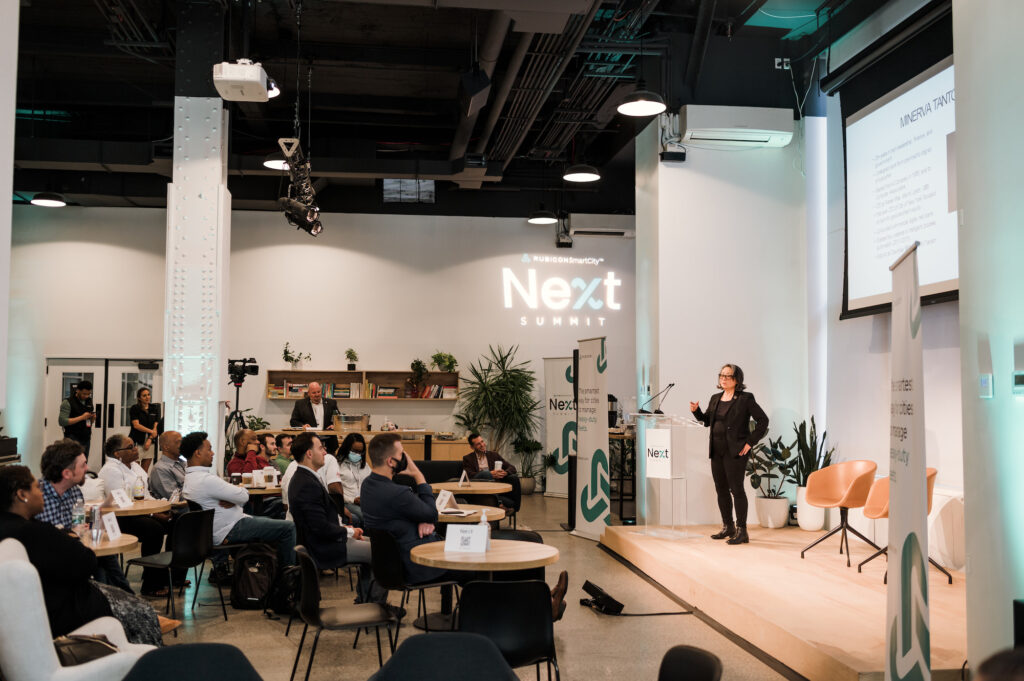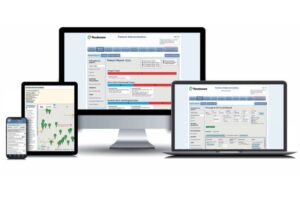NOTE: At the time this article was originally published, RUBICONSmartCity was not part of Routeware’s suite of technology solutions. RUBICONSmartCity was acquired by Routeware in August 2024 and has since been fully integrated into the company’s offering.
At RUBICONSmartCity™ Next Summit 2022, Minerva Tantoco spoke about her tenure as New York City’s first Chief Technology Officer from 2014 to 2016. She reflected on her experience pioneering New York’s push to become a smart city, discussed the intentional strategy she used to approach technological innovation, and explained how that shaped her team’s projects.
If you missed Tantoco’s presentation, we will cover three main takeaways from her keynote.
Technology Should Serve Everyone
Tantoco described the New York City she envisioned during her tenure: “Not just a smart city, but a smarter and more equitable city.” She wanted to use new technology to benefit all New Yorkers instead of focusing on the city dwellers who already used technology every day to improve their lives.
One of her main priorities was providing internet access for everyone. She explained that, in 2014, a quarter of the households in New York City didn’t have access to broadband internet and this was not just a matter of cultural relevance. Without access, residents were cut off from vital resources such as email, job applications, and benefit applications. That was why she decided the city should invest in broadening and democratizing access to WiFi.
When Tantoco began her term in September 2014, she learned that the City’s payphone contracts would expire in three months. During Mayor Bloomberg’s tenure, it was decided they should replace payphones with something that could serve as a solution to the Wi-Fi equity problem. In that three-month period, she selected new vendors, negotiated new contracts, and gained borough approval to build the LinkNYC kiosks. Of this experience, Tantoco noted that “A little fire helps the creative energy.”
These kiosks provided the fastest Wi-Fi available at the time. In addition to offering free internet, they were ADA compliant. Their height ensured anyone could use them, and their keyboards had braille. Tantoco’s team also added a 911 button, so they could also serve a public safety function.
LinkNYC kiosks are an example of how technology was used to make New York City a more equitable place. She said there were initial protests and complaints, but having recently seen a wheelchair user using the kiosk tablet to apply for benefits she was reassured that this was a valuable advancement for the community.
Introduce Useful Tech Industry Practices to Government Agencies
Having left a CTO position in the private sector to work in city government, Tantoco brought a wealth of new ideas to her office, including one she described as “iterative development,”—which breaks a larger product or process into smaller parts to evaluate if they could be used in other ways.
In the technology field, Tantoco explained, employees consider how they can use a project’s tools in new ways, or how they can tweak the tools to make constant improvements.
As New York City’s CTO, she encouraged agencies to maximize the resources they had at their disposal. She suggested agencies try ‘hackathons’, inviting both employees and constituents to participate. The NYC BigApps Competition, which provides programmers, developers, designers, and entrepreneurs with access to municipal datasets to build technological products that address civic issues affecting New York City, was a prime example. The contest provided designers, programmers, and entrepreneurs with access to data collected by the City.
Tantoco cited the Department of Sanitation as one of the most innovative agencies she worked with, also noting the importance of Rubicon’s work with other cities on their waste management operations.
The Best Ideas Come from Data
When it comes to innovation, Tantoco believes that the focus needs to be on people. She said, “It isn’t about the tech; it’s about what we can do with it. How do we make tech a force for good?”
She shared that the way to guarantee that technology is beneficial for people is to understand their needs. The question then is: how do you know what people need? You could ask them, yes, but Tantoco pointed out that holding a community meeting or a city hall meeting does not mean you are hearing from the majority of your constituents. Many citizens cannot attend these meetings because of work commitments, transportation, or child care constraints. Alternatively, Tantoco used data to determine which neighborhoods would benefit from new technologies based on metrics such as average income levels within a certain community. Innovation labs were also strategically placed in the neighborhoods they intended to improve, allowing citizens to have more visibility into the projects that would impact them, and welcoming their input.
Tantoco said data is the key to making sure tech is focused on solving inequity going forward.
Citing an example to show how data can be useful, she explained that the NYC Department of Transportation put GPS devices on City buses and the traffic lights they passed on their routes. These GPS devices communicated with one another so that, if a city bus were approaching a light, it would stay green longer to allow the bus to pass through the intersection. This slight change was enough to shorten commute times and reduce pollution as it minimized the time a bus spent idling. Data showed that commute times were reduced by 20 percent.
Data showed that the experiment was a success, and the changes were applied to other bus routes, improving the rest of the City’s congested corridors.
Tantoco emphasized the importance of intention in innovation and that new technology must be used to benefit the most people possible in order to create a truly smart city.
Interested in learning more about what we can do for you? Get Started today with your initial quick and free consultation.





